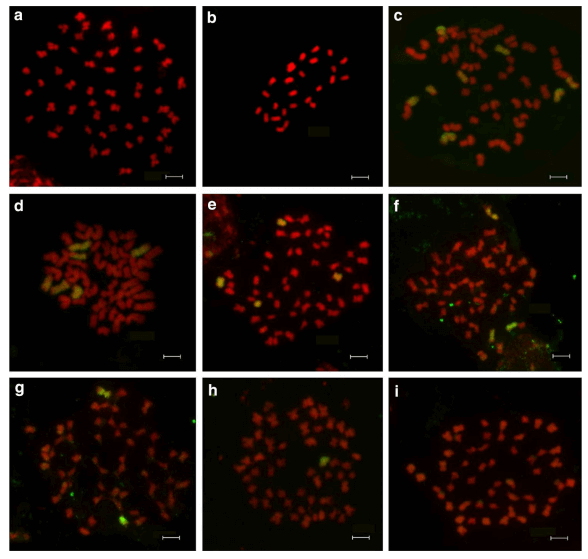Hybrid Offspring Chromosome Painting
Creative Bioarray provides FISH services for analyzing different types of hybrid progeny produced by cross-breeding. Many types of hybrid progeny can be obtained through interspecific and intergeneric hybridization, such as alien gene introgression lines, alloplastic lines, and monosomic alien chromosome substitution lines. Such methods can provide materials useful for the development of practical breeding strategies and the study of the genetic effects of individual chromosomes on plant traits. FISH has become a molecular method to quickly visually analyze the chromosome composition (chromosomal variation) and genome composition of hybrid offspring. The knowledge obtained through analysis can be used to estimate the number of genes controlling traits, describe their linkage relationships, and use this knowledge to genetically improve crops. Our hybrid offspring chromosome drawing service can perform chromosome analysis for different types of hybridization schemes.
Multiple Types of Hybrid Offspring
The hybrid offspring produced by different hybridization methods have different characteristics, and mastering these characteristics is of great significance to our rapid analysis. The infertility problem of the offspring of the hybrid offspring can be solved by techniques such as embryo rescue, which further expands the possibility of obtaining hybrid offspring through somatic cell hybridization. Taking intergenus/interspecific hybrid breeding as an example, this method can produce many types of offspring, including synthetic amphidiploid lines, alien gene introgression lines, alloplastic lines, monosomic alien chromosome addition lines, and monosomic alien chromosome substitution lines. Our hybrid progeny chromosome drawing service can be used for chromosome visualization analysis in projects such as the breeding of known diploids, the screening of single foreign chromosome addition lines, and the identification of foreign gene introgression lines. At the same time, it can also analyze and classify unknown types of hybrid cells.
 Fig 1. An analysis case of alien chromosome additions based on the genomic in situ hybridization. (Tang et al., 2018)
Fig 1. An analysis case of alien chromosome additions based on the genomic in situ hybridization. (Tang et al., 2018)
Genetic Analysis and Chromosome Painting
FISH/GISH technology for visual analysis of crop chromosomes is very powerful. Chromosome analysis can help breeders quickly access the chromosomes of offspring, and use fluorescence microscopy to observe offspring chromosome composition or locate specific chromosomes. Our goal is to provide personalized, customized scientific research services and products for customer projects. This service is for customers who need to visualize the chromosomes of the first generation hybrid seeds. There are different types of hybrid progeny in different agricultural breeding programs, and our probe customization service can help researchers to carry out genetic analysis as soon as possible. The types of hybrid progeny that our service can handle include synthetic double diploid systems, foreign gene infiltration systems, heterologous systems, monosomic foreign chromosome addition systems, and monosomic foreign chromosome replacement systems. Based on a wide range of custom fluorescently labeled probe products and advanced fluorescence microscopy equipment. Our products will help customers obtain high-quality analytical data. Our scientists will communicate with you about the probe customization plan, including parent and probe information.
Creative Bioarray provides high-quality FISH detection services and is committed to being the leading provider of personalized probes. Customized probes will be suitable for rapid analysis of hybrid progeny for chromosomal variation associated with molecular breeding. You will benefit from our technical expertise and equipment platform. If you are interested in our chromosome painting service, please contact us for cooperation. We look forward to cooperating with you in the near future.
References
- Tang D, Feng S, Li S, et al. Ten alien chromosome additions of Gossypium hirsutum–Gossypium bickii developed by integrative uses of GISH and species-specific SSR markers[J]. Molecular Genetics and Genomics, 2018, 293(4): 945-955.
- Takashima M, Bang S W, Kaneko Y. Production and characterization of monosomic addition lines of autoplasmic and alloplasmic Brassica napus with each B-genome chromosome of Brassica juncea[J]. Breeding Research, 2012, 14(4): 95-105.
All products and services on this website are only suitable for non-medical purposes.


 Fig 1. An analysis case of alien chromosome additions based on the genomic in situ hybridization. (Tang et al., 2018)
Fig 1. An analysis case of alien chromosome additions based on the genomic in situ hybridization. (Tang et al., 2018)


